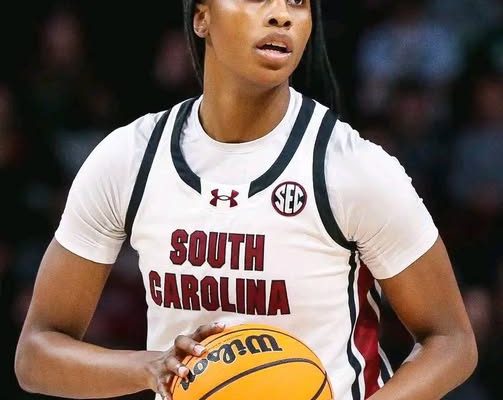The world of women’s college basketball has been rocked by a series of stunning revelations emerging from within the South Carolina Gamecocks program, a powerhouse that has long been a symbol of stability, dominance, and elite culture under the leadership of legendary head coach Dawn Staley. But recent allegations of internal strife, leadership clashes, and a sudden decline in team morale have set off alarms among fans and analysts, who are now openly wondering whether South Carolina’s reign atop the Southeastern Conference (SEC) is in jeopardy. At the center of this swirling storm is freshman phenom Joyce Edwards, whose meteoric rise and unparalleled talent have made her the face of the program’s future—yet her own future with the team now hangs in the balance as whispers of discontent grow louder.
For years, South Carolina’s women’s basketball team has been the gold standard of success in the SEC and beyond, capturing national titles, securing top recruiting classes, and sending stars to the WNBA. Staley, known for her fierce competitive spirit and unwavering commitment to her players, has cultivated an environment of excellence that has drawn some of the best high school talent in the nation to Columbia. But with dominance comes pressure, and behind the scenes, tensions have reportedly been brewing, culminating in what insiders describe as a “critical moment” for the program’s future direction.
Joyce Edwards, a once-in-a-generation talent and one of the highest-rated recruits in South Carolina history, was expected to step seamlessly into the spotlight, filling the void left by graduated stars and continuing the Gamecocks’ tradition of producing elite players. Yet sources close to the program suggest that Edwards has become an unwilling focal point of the team’s internal conflicts, caught between competing visions for leadership, clashes between veteran players and coaching staff, and the relentless media scrutiny that accompanies any high-profile athlete in today’s college sports landscape.
The crisis, insiders say, is not just about one player but a deeper rift within the team’s leadership structure. Several reports indicate that assistant coaches and veteran players have disagreed on key issues ranging from team strategy and practice intensity to off-court dynamics and the handling of NIL (Name, Image, and Likeness) opportunities. While Staley remains outwardly composed in public, there are mounting concerns that the team’s cohesion—a cornerstone of its past success—has begun to fracture. Analysts warn that such turmoil, if not resolved swiftly, could embolden SEC rivals like LSU, Tennessee, and Ole Miss, who are eager to exploit any weakness in the reigning powerhouse.
As news of the alleged unrest has trickled out, the Gamecocks’ fanbase has been thrown into a frenzy. Social media platforms have become battlegrounds of speculation and debate, with some fans expressing unwavering loyalty to Staley and the current coaching staff, while others question whether changes are needed to preserve the team’s long-term dominance. For a program that has built its brand on unity and resilience, the current situation represents uncharted territory.
Background: The Rise of South Carolina Women’s Basketball
To understand the gravity of the current crisis, it’s essential to look back at the incredible rise of South Carolina women’s basketball over the past decade. Before Staley’s arrival in 2008, the program had seen flashes of success but lacked the sustained excellence needed to compete with traditional SEC powers like Tennessee. Staley, a Hall of Fame player with a reputation for toughness and vision, changed all of that. Through tireless recruiting, a strong focus on player development, and a relentless pursuit of championships, she turned South Carolina into a perennial contender.
The 2016-17 season marked a turning point when the Gamecocks captured their first NCAA national championship, led by iconic players like A’ja Wilson. This victory solidified Staley’s status as one of the premier coaches in college basketball and made Columbia a destination for elite talent. Subsequent seasons saw continued dominance, including another national title in 2022, as well as multiple SEC tournament and regular-season championships.
Recruiting has been a cornerstone of this success, with South Carolina consistently landing top-ranked classes. Joyce Edwards, hailing from Camden, South Carolina, was widely seen as the crown jewel of the program’s latest recruiting haul. Her commitment was celebrated as not just a win for the Gamecocks but a sign that local talent would continue to fuel their national prominence. Edwards’ combination of size, skill, and basketball IQ has drawn comparisons to past greats, and many expected her to be a key factor in keeping South Carolina ahead of rivals like LSU—especially after Kim Mulkey’s aggressive recruiting campaigns in Baton Rouge.
The Allegations of Internal Turmoil
However, the path to sustained success is rarely smooth, and recent reports suggest that the Gamecocks’ inner circle is grappling with a range of challenges that go beyond the usual pressures of competition. According to sources speaking on condition of anonymity, there have been disagreements over coaching philosophy, with some players reportedly feeling that the current system stifles their creativity and places undue physical demands on them. Others have expressed frustration with how the program has navigated the NIL landscape, suggesting that not all players have received equal support or opportunities to capitalize on their marketability.
The situation has been further complicated by the expectations placed on Joyce Edwards. As a freshman, Edwards entered a program already under intense national scrutiny, and some insiders believe she has become a lightning rod for tensions between veteran players and the coaching staff. “It’s not about Joyce as a person,” one source explained. “It’s about what she represents—the future of the program, the new era of NIL, and the shift in how players see their value. That’s creating friction.”



